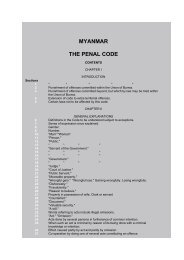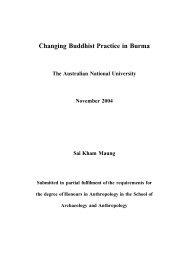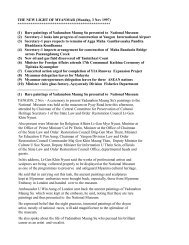20 December 2008 - Online Burma/Myanmar Library
20 December 2008 - Online Burma/Myanmar Library
20 December 2008 - Online Burma/Myanmar Library
Create successful ePaper yourself
Turn your PDF publications into a flip-book with our unique Google optimized e-Paper software.
6 THE NEW LIGHT OF MYANMAR Saturday, <strong>20</strong> <strong>December</strong>, <strong>20</strong>08<br />
Worm infestation, and Maternal and Child Health<br />
Professor Dr. Paing Soe<br />
Helminthes or worm infestation refers to worms<br />
that live as parasites in the human body and are a<br />
fundamental cause of disease associated with health<br />
and nutrition problems beyond gastrointestinal tract<br />
disturbances. These parasites consume nutrients from<br />
children they infect, thus retarding their physical<br />
development. They destroy tissues and organs, cause<br />
abdominal pain, diarrhea, intestinal obstruction,<br />
anemia, ulcers and other health problems. Heavy or<br />
long-term intestinal worm infection frequently results<br />
in death if treatment is not given in time. All of these<br />
consequences of infection can slow cognitive<br />
development and thus impair learning in these children.<br />
Globally, one-third of population is infected<br />
with intestinal worms, of which 2 billion are<br />
unknowingly facing the adverse effects of worm<br />
infestation. Among those infected, 1.47 billion are due<br />
to roundworm, 1.3 billion people due to hookworm<br />
and 1.05 billion due to whipworm. Hundreds of<br />
millions of people do not enjoy a healthy, productive<br />
life because they are debilitated and unable to achieve<br />
their full potential. Parasitic infections contribute<br />
significantly to this widespread deprivation. Parasitic<br />
infections are the hallmark of poverty and<br />
underdevelopment. Soil-transmitted worms infestation<br />
due to roundworm, whipworm and hookworm and<br />
water-transmitted Schistosomiasis occur all over the<br />
world. Pregnant women and school children aged 5-14<br />
years suffer the highest infection rate and worm burden<br />
that attributes to poor sanitation and hygiene. About<br />
400 million school-age children are infected with<br />
roundworm, whipworm and hookworm worldwide.<br />
According to a study conducted in Thailand in<br />
1996, common helminthes were hookworm (21.6%),<br />
whipworm (3.9%) and roundworm (1.9%). In Vietnam,<br />
a nationwide estimation on roundworm infection is<br />
about 60 million and hookworm is about 40 million in<br />
<strong>20</strong>00. In one study conducted in Cambodia at 1997<br />
showed that children were mostly infected by soiltransmitted<br />
worms.<br />
Worm and maternal health<br />
Anaemia is one of the main underlying causes<br />
of poor pregnancy outcomes in the developing world<br />
and is caused by general nutritional deficiencies and<br />
worm infestation. In developing countries, 75% of<br />
pregnant mothers are suffering from moderate to severe<br />
anemia. Women and adolescent girls bear a particular<br />
burden of losing blood due to hookworm infection<br />
resulting in iron deficiency anemia. Heavy infection<br />
with hookworm causes anemia among women, which<br />
is believed to be one of the factors contributing to<br />
maternal morbidity and mortality. In anemic women,<br />
the risk of dying during pregnancy or childbirth is<br />
about 3.5 times higher than in non-anemic women.<br />
A recent study conducted in Nepal showed that<br />
de-worming pregnant women could bring about much<br />
more advantage than expected. That study was<br />
conducted by John Hopkin’s Bloomberg School of<br />
Public Health and found that 74 percent of pregnant<br />
women in Nepal were infected with hookworm and<br />
that 54 percent had moderate to severe anemia because<br />
of the worm. Most of the women in the study were<br />
given one pill of the drug albendazole in both the<br />
second and third trimester of pregnancy at (5 th and 8 th<br />
of pregnancy). When researchers checked on infants at<br />
six months, they found 14% fewer deaths among<br />
infants of mothers given one dose of the drug and 41%<br />
fewer deaths of children whose mothers were given two<br />
doses.<br />
Since anemia reduces resistance to blood loss,<br />
death may occur from bleeding associated with normal<br />
delivery. Association of anemia with worm infestation<br />
which can lead to adverse maternal outcome such as<br />
puerperal sepsis, antepartum hemorrhage, postpartum<br />
hemorrhage and maternal mortality is no longer a<br />
debatable issue. Presence of parasitic infestation and its<br />
relationship with anemia and fatal outcomes was also<br />
studied by Stratton and associates in the United States.<br />
They found that, there was a significant three-fold<br />
increase in the incidence of neonatal hyperbilirubinemia<br />
in mothers that had the presence of helminthes in the<br />
stool. Hook worm and ascariasis were the main causal<br />
parasites of anemia.<br />
Worm and child health<br />
Estimates have been made of the quantitative<br />
costs of worm infections to cognition and education by<br />
WHO. The total lost years of schooling due to wormassociated<br />
absenteeism amounts to over <strong>20</strong>0 million<br />
years; with almost all this loss occuring in developing<br />
countries. The average IQ loss per worm infection is<br />
3.75 points. Feeding a child infected by worms is like<br />
filling a leaking bucket with water and such children<br />
always suffered from nutritional deficiencies. Worm<br />
infection weakens very young children in ways that<br />
increase their vulnerability to infectious diseases. One<br />
recent study indicated that worm infections disrupt the<br />
immune response in ways that could hasten the<br />
progression from HIV infection to AIDS. Anemia caused<br />
by worm infection worsens malaria. Recent studies<br />
conducted in areas where malaria is a major childhood<br />
killer showed that deworming and the resulting reductions<br />
in anemia improve the chances of surviving severe<br />
malaria. Deworming school children by anthelminthic<br />
drug treatment is a curative approach for expelling the<br />
heavy worm load. Deworming increases attendance at<br />
school not only because they are free from illness but<br />
also because their cognitive performance improves and<br />
they learn significantly better.<br />
Treatment and Prevention<br />
Anthelminthic treatment is recommended for all<br />
risk groups, adolescent girls, pregnant mothers, schoolaged<br />
children and also recommended for children as<br />
young as 12 months because it improves their health. By<br />
reducing anemia, deworming drugs which can be safely<br />
administered during pregnancy, contribute directly to<br />
maternal survival. Abundant evidence shows that regular<br />
deworming reduces anemia in adolescent girls and<br />
women of childbearing age, thus preparing them for a<br />
healthier pregnancy. Deworming drugs should be taken<br />
6 monthly (2 times a year). However, drug therapy alone<br />
is only a short-term measure of reducing worm infection<br />
and re-infection is frequent. Control measures through<br />
improved sanitation, hygiene and deworming are needed<br />
to prevent infection and re-infection.<br />
A national survey performed in school-age<br />
children of Cambodia, dewormed using Mebendazole<br />
500 mg indicated intestinal worms dropped to about<br />
one-third of the initial level, but re-infection occurs<br />
frequently because of a lack of access to adequate<br />
sanitation, safe water and unhygienic habits. A children’s<br />
deworming programme has proven to be an effective<br />
entry point and educational tool to create the demand for<br />
household sanitary latrines, for use of safe water and<br />
improved hygiene behavior change in communities<br />
based on some project experiences. One successful<br />
pilot project was implemented in ten villages in West<br />
Bengal, India, to promote a package that consisted of<br />
deworming young children, hygiene education,<br />
improved sanitation by building family toilets, and<br />
chlorination of drinking water at house level by<br />
housewives. On seeing worms coming out from their<br />
children bodies, parents were convinced of the need for<br />
a clean environment, for the use of sanitary toilets and<br />
for hand washing with soap. An 80% reduction of<br />
childhood diarrhea was achieved within 12 months of<br />
intervention and many households had built and used<br />
simple sanitary toilets.<br />
The project proved that hygiene education alone<br />
would not lead to behavior change unless strengthened<br />
by the availability of safe drinking water and sanitary<br />
facilities in an enabling environment. UNICEF has<br />
supported many governments in this (and other) regions<br />
to assist in the provision of water supply and sanitary<br />
facilities and intensive hygiene education in many<br />
schools through the Water, Environment and Sanitation<br />
(WES) programme. The UNICEF supported school<br />
sanitation and hygiene education (SSHE) programme,<br />
and other programmes that could effectively enhance<br />
behavior change in children to break the routes of<br />
worm transmission and other waterborne diseases.<br />
Implementation of any helminth control<br />
programme at country level requires strong links with<br />
existing interventions that are already in place to reach<br />
women and children. e.g., deworming may hitch a lift<br />
from health care programme like immunization, vitamin<br />
A supplements, antenatal care. This intervention has<br />
been successful in the Democratic People’s Republic<br />
of Korea and in several other counties. Today, control<br />
of these infections can be achieved through regular<br />
treatment with inexpensive, single-dose and highly<br />
effective drugs, so safe they can be given to all groups<br />
at risk.<br />
Deworming improves not only health and<br />
development of individual but also development of<br />
the nation. Deworming is a particularly effective<br />
intervention because the capacity costs are<br />
negligible. It is an investment for future health and<br />
development and the small investment that can<br />
give a large profit. Periodic administration of<br />
anthelminthic tables to school-age children is now<br />
part of the policy of many well-designed school<br />
health programmes in endemic countries. This<br />
intervention is expanding all over the world towards<br />
the 75% global coverage target. WHO’s target is<br />
regular treatment of at least 75% of all school-age<br />
children at risk of morbidity for schistosomiasis<br />
and soil-transmitted helminth infections by <strong>20</strong>10.<br />
There is evidence that antheminthic treatment of<br />
women during pregnancy improves maternal health,<br />
increases birth weight and reduces infant mortality.<br />
Benefits for participating communities include<br />
increases in growth rates of children, better school<br />
attendance and performance, improved iron status,<br />
decline in anemia rates, healthier pregnancies and<br />
birth outcomes, and greater adult productivity<br />
leading to development of the nation. Therefore,<br />
let’s promote maternal and child health by<br />
deworming with safe, effective and inexpensive<br />
anthelminthic drugs and by improving personal<br />
hygiene.<br />
(see page 7)<br />
<strong>20</strong>-12-08 NL 6<br />
7/29/18, 2:03 PM
















